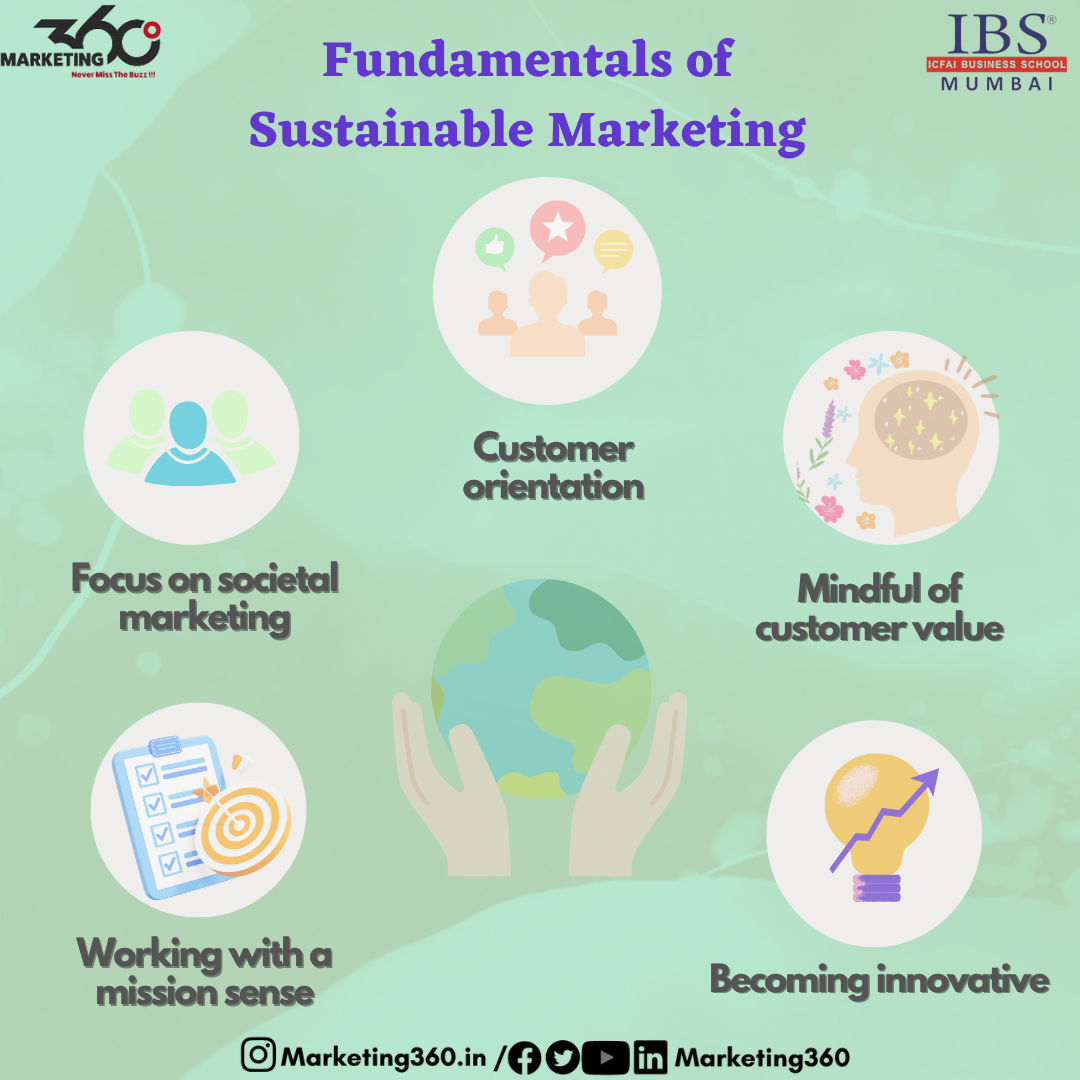
Key Takeaways:
- Only 100 companies are responsible for 71% of global greenhouse gas emissions. That is the power of long-term marketing. If each of these 100 companies used sustainable marketing, global emissions would be drastically reduced.
- Three pillars constitute sustainable marketing: the economy, society, and the environment.
- Brands are changing their emphasis from generating revenue to discovering social missions. Examples – Lego, Starbucks, Levi’s’ etc.
- The sustainable marketing strength lies in customer value and societal marketing which has made the brands customer oriented.
- The major advantage of brands to leverage is high brand recognition along with low cost and increased productivity.
To satisfy consumer requirements while protecting future generations, marketing must be sustainable. The goal of sustainable marketing is to involve the brand actively in resolving a social or environmental issue. It can make your brand communications more relatable and provide them another reason to choose you over your competitors.
Sustainable marketing set up several distinctive marketing initiatives with the goal of raising awareness of the brand’s eco-friendly goods and services for its customers. In today’s time, the definition of sustainable marketing has evolved and is integrated with defining the brand value of the product. Sustainable marketing echoes with the customer and establishes a strong brand value over time in return of higher profits and customer retention. It currently includes all of the elements that contribute to an organization’s success on a cultural, economic, social, and environmental dimension. As a result, sustainable brands resonate with customers over time. The goal is to maintain constant brand value to prevent short-term gains at the expense of long-term objectives.
Sustainable marketing works because it promotes the core values that your company and its stakeholders value –sustainability in terms of environmental wellness, human health, resource security, fair trade, social equity, and so on. As a result, sustainable marketing distinguishes your company’s advertising in a market dominated by the traditional “put-down” style of advertising. By engaging in sustainable marketing, the brand will gain the trust and loyalty of its customer which in the long term will increase brand value and brand identity. And for today’s customer, loyalty is the most valuable competitive advantage of all which helps attain the brand value of a company.
Three pillars constitute sustainable marketing: the economy, society, and the environment. Sustainability strategies focus on preserving limited natural resources and the integrity of the planet’s environmental systems. In addition, it entails preserving economic expansion and resource access. It implies safeguarding human resources and making sure that everyone has access to the necessities of life. Making a good difference for the planet and its inhabitants is the goal.
Brands are now shifting their focus away from just profits and toward evaluating themselves from a new perspective. Today’s businesses focus on the triple bottom line, taking into account profit, people, and the planet. This has assisted brands in changing their emphasis from generating revenue to discovering social missions.
The beginning and development of sustainable marketing
The definition of sustainable marketing and the frequency of its adoption have drastically altered throughout time. When sustainable practices first emerged in the 1970s, people thought of them more as a luxury than a useful tool for running a successful company.
An intriguing finding on new customer willingness and the growth of “green consumers” was made in the early 1990s. Businesses started to view sustainable marketing strategies as a strategic imperative as a result of these new environmentally conscious consumers, governmental changes, and social pressures.
Given the global trend toward corporate social responsibility, incorporating the sustainability ethic into your business strategy and engaging in sustainable marketing is the best way for your company to move forward
The Fundamentals of Sustainable Marketing
1) Customer-Orientation: Big-picture thinking is a fundamental skill for consumer-focused marketing. Whether or not the advertisement will appeal to the target audience is more important than whether it looks good or not. This requires taking into account contextual elements like current affairs and popular culture.
2) Mindful of customer value: It refers to providing customers with additional value in the form of goods or services. It’s a mutually beneficial connection. Customers will support a brand more heavily the more value it offers them.
3) Becoming Innovative: Nowadays, especially in a globally competitive industry, it is crucial to use new marketing techniques. Making this a top priority will assure ongoing improvement, which is a terrific way to stay current and offer clients value.
4) Working with a Mission-Sense: Keep in mind that your target market must find the mission marketing notion appealing. It’s not a good idea to claim that the business is making every effort to conserve the turtles while the target consumer has no interest in them. Conducting market research and establishing a sense of direction is essential to serving the interests of the customers.
5) Focus on Societal Marketing: In general, this calls for extreme diligence. It entails paying attention to the preferences and long-term interests of your client. Taking into account the interest of society at large.
Steps to successful Sustainable Marketing
1) Be genuine: To begin with, authenticity is essential in any marketing campaign. This is especially true if a brand wants to stand out and set a good example for sustainable practices.
2) Concentrate on your product or service: Customers are loyal to a brand because of the products and services it provides. Furthermore, providing high-quality products while adhering to the sustainable marketing concept is a sure way to keep the customers loyal.
3) Simplify communication: Overcomplicating the campaign messaging can confuse the audience. Instead, always stick to the point and be clear about what the brand wants customers to know.
4) See the big picture: Seeing the big picture is one of the most important characteristics of sustainability marketing. Furthermore, finding solutions for current and future generations. As a result, always strive for a broader perspective
5) Think about being transparent: As some of the examples above show, being transparent is often a fruitful marketing strategy. Don’t be shy or secretive; instead, open up to your customers and show them what your brand truly stands for.
The Importance of Sustainable Marketing
- Customers will eventually abandon a company if it is unable to maintain sustainable marketing.
- Customer retention is difficult to sustain if the company is unaware of its customers’ needs and desires.
- At the heart of a brand’s success and long-term marketing is the alignment of customers’ and brands’ values.
- Awareness of the need for environmentally friendly and sustainable businesses and marketing has grown over time. As a result, companies must consider this if they want to connect with their target audience.
- Government policies are highly oriented toward sustainability. The constant depletion and rising costs of resources should prompt businesses to seek out sustainable marketing and business processes.
Advantages of Long-Term Marketing
- Better brand recognition: An environmentally conscious brand is sure to resonate with an increasingly environmentally conscious audience. Customers will like a brand if they believe it is serious about sustainability marketing.
- Lowering costs and increasing productivity: With the cost of resources steadily increasing, a long-term marketing strategy will end up saving money. This is because it entails looking for alternatives whose prices will not rise over time.
- Makes it easier to comply with government regulations: Governments have steadily implemented environmental policies. Sustainability marketing implies that the company will have an easier time meeting the regulations.
- It is simpler to acquire new customers/partners: Environmentally conscious customers will be drawn to the brand through marketing as a result of improved brand image. This means that long-term marketing improves customer acquisition.
- Reduced wastage: Sustainable marketing will reduce environmentally harmful waste if the business is geared toward a more environmentally friendly path.
- Increased Return on Investment: In the long run, lower resource costs mean that companies will make more profits through sustainable marketing, and the ROI will eventually improve.
Examples of brands thriving on Sustainable Marketing
Lego
Beginning in September 2020, the LEGO Group will invest $400 million in sustainable marketing and social responsibility initiatives over three years. The emphasis will be on both current and future processes. Since 2015, the LEGO Group has been on a mission to use only sustainable materials by 2030. The group has a Sustainable Materials Program with 150 specialists working toward this goal. Currently, 2% of LEGO is made of sugar cubes, to eventually expand to include all bricks. As the company transitions to renewable energy, onsite capacity will increase. It aims to reduce water consumption by 10% by 2022 and landfill waste by 25% by 2025.
Starbucks
Starbucks has done an outstanding job of expertly cultivating an excellent reputation. Not only is it known for high-quality coffee, but people are pleased to know that Starbucks is concerned with social impact. This is the ideal combination of creating customer value and appealing to values. Finally, the company refused to use plastic straws, used green packaging, sourced its coffee responsibly and ethically, and only used materials that were sustainable during production. Keep in mind that they’ve started doing this since the early 2000s. Furthermore, they regularly donate millions of dollars to environmental initiatives.
Levis
Levi’s has decided to reduce the amount of water used in the production of jeans. There are now over 20 processes geared toward manufacturing without water waste. This is part of the company’s “Water<” initiative.
The initiative is aimed at the final stage of jeans production, specifically denim finishing. As a result, it has reduced water waste by 96%. More than 67% of Levi’s products are part of the Water<TM initiative. It has recycled 1.5 billion litres of water so far. Three billion litres of water were saved. Levi hopes to see the same figure rise to 80% by 2020.
Nike
As part of its sustainability marketing strategy, Nike has decided to reduce greenhouse gas emissions by 65% by 2030. The supply chain would like to see a 30% reduction in the same. Furthermore, Nike intends to use environmentally friendly products to the tune of 50% of all materials used over the next half-decade. This should result in a reduction of about 0.5 million tonnes of greenhouse gas emissions. Its sustainability marketing strategy is based on three principles: sustainable materials, renewable energy, and energy efficiency. The company has been investing resources in researching sustainable raw materials. Nike will also look for ways to reduce its carbon footprint and then market them on a large scale.
Apple
Apple devotes approximately 25% of its sustainability efforts to reduce its carbon footprint to zero. For this, the company has partnered with forest conservation organizations. Furthermore, 75% of Apple’s sustainable marketing strategy focuses on reducing production waste and utilizing renewable energy.
The tech titan has very close relationships with its suppliers. This has enabled it to obtain commitments from 70 of its suppliers to completely switch to renewable energy. When these companies reach their targets, their carbon footprint will be reduced by 14.3 million metric tonnes. That is equivalent to having approximately 3 million fewer cars on the road. Apple has also collaborated with the US-China Green Fund. So far, they have committed $100 million to energy-efficient programs focusing on supply chains.
PepsiCo
PepsiCo has received harsh criticism in the past for the way they conduct business. This, however, signalled a positive shift in the company’s sustainability standards. PepsiCo has achieved 88% of its goal of using 100% recyclable, biodegradable, and compostable packaging. PepsiCo has far exceeded its goal of providing safe water to 25 million people since 2006, thanks to the Alliance of Water Stewardship (AWS).
Bacardi
Up until recently, we’ve known Bacardi as a rum producer. People are now wondering if Bacardi is the brand that has solved the world’s plastic problem. Bacardi has developed a biodegradable bottle that degrades in 18 months, whereas other plastics take hundreds of years. Bacardi, which did not begin as a company concerned with sustainability, is now one of its forerunners. If your company has sustainable products or practices, sustainable marketing becomes the easiest thing in the world.
Conclusion
Sustainable marketing aims to improve people’s lives by marketing environmentally friendly and sustainable products and services. Customers’ environmental consciousness has grown over time. As a result, environmentally and socially responsible marketing can go a long way toward attracting them. Traditional marketing methods are used in sustainable marketing, but the goal is to improve the environment and people’s lives, as well as to shoulder social responsibility. Businesses should be open about their plans to improve the environment.
It’s no secret that businesses cause significant environmental damage. Only 100 companies account for 71% of worldwide greenhouse gas emissions.
That is the power of long-term marketing. If each of these 100 companies used sustainable marketing, global emissions would be drastically reduced. While smaller businesses may not have a large impact, changing the way we do business sets a new standard for businesses all over the world. As more businesses adopt sustainable marketing, expectations will shift, forcing larger corporations to become more environmentally friendly.
Our path to a wave of change is through sustainable marketing. Adopting sustainable marketing among smaller businesses may eventually lead to changes in the procedures of the largest emitters.
Sustainability certification programmes are an excellent way to kick-start your green mission and map out the best path to success. Green Business Bureau offers a variety of tools and marketing opportunities to help you realise your full potential as a green business.

Isha Goel
Content Credits

Sanskruti Wani
Editor Credits

Vidhi Maheshwari
Graphic designer

Usually I do not read article on blogs however I would like to say that this writeup very compelled me to take a look at and do it Your writing style has been amazed me Thank you very nice article
Dear marketing360.in administrator, Your posts are always informative and well-explained.